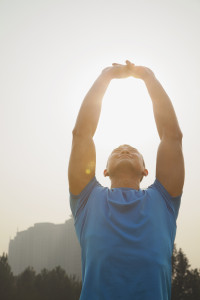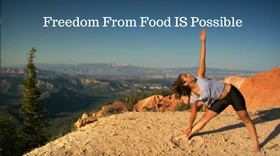Intuitive Movement
Recognizing the Benefits of Joyful Movement for Every Body
Research consistently shows that regular movement is correlated with improved mood, decreased depression, and an overall feeling of peace and well-being. And who doesn’t want that?
Why-oh-why then, is it SO hard to get into a movement routine!?!
When Did “Exercise” Become a 4-Letter Word?
At TheHealthyWeighOut, we know how difficult it can be to start a physical movement routine, especially if you are living in a body that aches with movement, moves slowly, or just doesn’t feel like yours. Physical limitations, weight-related fatigue, and past experiences with negative judgments from others in traditional gym settings are all sad realities frequently mentioned by our clients who may desire engaging in a movement or exercise program, but have instead opted to stay home due to feeling uncomfortable or ashamed.
Sometimes people come to us having had an excessive past relationship with exercise. They were compulsive or driven by the desire to lose weight too quickly and they “burned out” on exercise as a result. Other times, clients report having had past experiences with overly aggressive trainers or gyms that pushed them too hard, leading to chronically sore muscles, fatigue, or injury. Sometimes, clients tell us that they are “bored” by the redundancy of typical exercise routines and would rather do anything but walk one more mile on the dreaded treadmill!
At TheHealthyWeighOut, we wholeheartedly believe that when physical movement is approached in a manner that is enjoyable, interesting, creative, and respectful of your current physical abilities and health, individuals are able to engage in consistent movement that supports successful and sustainable achievement of your physical goals.
TheHealthyWeighOut Approach to Movement
TheHealthyWeighOut is proud to embrace an innovative, creative approach to physical activity that we developed to help our clients move past their barriers to exercise, and to help them come to love healthy MOVEMENT once again!
We call our creative, enjoyable approach to physical activity, “Intuitive Movement.”
What is “Intuitive Movement?”
Intuitive movement is engaging in physical activity that meets your body’s physical needs and, therefore, is experienced as enjoyable. Rather than “telling yourself” you “have” to do a certain activity, intuitive movers ask themselves, “What do I feel like doing today?” This might be walking around the park on a beautiful Tuesday, and running around the block on a Friday. It might be training hard in the studio to get out stress on a Wednesday, and taking a slow walk with a dear friend on a Thursday. It might be planning to attend a yoga class on Sunday morning, but then waking up and not feeling up to it so giving yourself permission to stay home and rest instead.
Similar to “Intuitive Eating,” which encourages people to eat foods that are both nutritious and enjoyable, intuitive movement is based on the principles of engaging in movement that is both good for you and enjoyable!
Examples of Intuitive Movement may include:
 Walking around a park with your kids as they ride their bikes
Walking around a park with your kids as they ride their bikes- Dancing to music that you enjoy
- Hiking in the mountains during the spring
- Swimming
- Jogging alongside your dog at sunset
Rather than rigidly focusing on the number of calories burned, heartbeats per minute, or average speed run, intuitive movers seek out physical activities that help them to feel strong, confident, and proud of their bodies. Furthermore, intuitive movers allow their bodies to rest, especially on days when they don’t feel physically well.
Even more “traditional” aerobic gym activity can be “intuitive” if it is done in response to your body’s own personal needs and signals. Examples of this may include:
- Riding a stationary bike to release stress
- Walking fast on a treadmill to train for a personal goal of jogging in a 5k event
- Engaging in strength training because it makes you feel strong and builds your confidence
Research consistently shows that when people establish an Intuitive Movement routine which, by definition, is moderate, flexible, and enjoyable, they are far more likely to maintain a long-term commitment to physical activity and to achieve healthy sustainable physical health!
Will Intuitive Movement Work for Me?
Yes! When you give yourself and your body permission to move in ways that feel good to you in any given moment, you begin to develop a physical body that builds competence with increased physical movement and excitement about all of the fun options for movement.
In our program, you will learn the principles of Intuitive Movement and identify ways in which you can build fun movement into your life that leaves you feeling energized and joyful!
You may have heard the term ‘Intuitive Eating,’ which is defined by eating when you’re hungry and stopping when you’re full, and eating for both nutrition and pleasure. Intuitive Movement utilizes the same philosophy except with physical activity — moving in a way that is healthy for your body and mind, without being rigid or punitive. Intuitive movement embraces all types of physical activities, particularly ones that you find fun and enjoyable!
Intuitive movement embodies several key principles:
- Individualized: movement of choice is based on how one feels physically and emotionally, rather than a rigid schedule that dictates what one has to do or should do regardless of how they feel; intuitive movers are able to listen to their bodies and respond appropriately
- Mindful: all five senses are incorporated into movement, allowing for a heightened awareness of one’s experience; practices like yoga and meditative walks provide opportunities for mindful movement
- Joyful: intuitive movement is enjoyable, fun, and uplifting; you give yourself permission to not engage in activities that are boring, overly challenging, or just not fun
- Diverse: all types of movement are embraced and encouraged; from archery to Zumba, intuitive movement avoids labeling physical activities as “good” or “bad” based on intensity, duration, or frequency
- Flexible: intuitive movement does not follow a rigid schedule or plan that must be followed, it simply relies on your self-awareness to determine what kind of movement would be best suited for you that day; when you’re injured, sick, or in pain, movement is stopped until you’re feeling strong enough to resume
